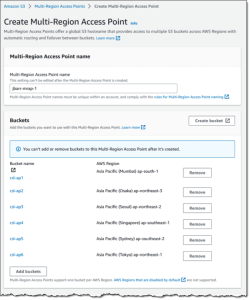
Why you can trust us
- 407 Cloud Software Products and Services Tested
- 3056 Annual Software Speed Tests
- 2400 plus Hours Usability Testing
Our team of experts thoroughly test each service, evaluating it for features, usability, security, value for money and more. Learn more about how we conduct our testing.
Key Takeaways: Duration of a Sprint
- Sprints generally last one to four weeks, with the average sprint duration being two weeks, allowing for focused work and more feedback loops.
- Short sprints — those lasting one to two weeks or less — are suitable for teams working on small tasks that require immediate feedback.
- A longer sprint, which lasts three to four weeks, is appropriate for complex, large-scale projects or in-depth work that requires more time.
Facts & Expert Analysis About Sprint Duration:
- Factors: Sprint length is determined by team dynamics, team size, project complexity, feedback loop requirements and the project management framework in use.
- Decider: During sprint planning, everyone on the team agrees on the number of weeks and the amount of work to be completed within the sprint time frame.
- Decider: During sprint planning, everyone on the team agrees on the number of weeks and the amount of work to be completed within the sprint time frame.
- Best practices: Shorter sprints are generally more effective than longer ones, but it’s recommended to experiment with different sprint lengths to find the one that works best for your team.
Sprints allow teams to break down complex projects into more manageable chunks. Determining the right sprint duration for your team — along with the best management software — is essential for maintaining productivity and keeping your project on track. In this guide, we’ll look at how long sprints should be and what factors you should consider.
Below, we’ll dive into the factors that influence sprint duration, the pros and cons of shorter and longer sprints, and how to find the sweet spot that works best for your team. We’ll also cover related topics, such as sprint planning and sprint reviews, to provide you with a comprehensive understanding of the sprint process.
Meet the experts
Learn more about our editorial team and our research process.
What Is a Sprint? Definition
A sprint is a short, fixed time period in Agile project management frameworks like Scrum. It enables teams to break down large projects into smaller, manageable chunks and focus on delivering a shippable product increment. This iterative process ensures that teams can quickly adapt to changes and continuously deliver value to meet stakeholder expectations.
The sprint cycle consists of several key processes: sprint planning, daily scrums or stand-up meetings, a sprint review and a sprint retrospective. The next sprint starts shortly after the previous one is completed.
Project Management
Check out our project management courses and grab a limited-time offer.
Registration available now!
Enroll Now
What Is the Ideal Duration of a Sprint?
Sprint length, or the duration of a sprint, ranges from one to four weeks. Two-week sprints are the most common sprint length, which balances the ability to deliver meaningful work with the flexibility to adapt to changes. However, the ideal sprint duration varies depending on factors such as team dynamics, team size, project complexity and feedback loop requirements.
Sprint Duration in Agile
Agile frameworks differ in their sprint lengths. For example, the Dynamic Systems Development Method (DSDM) has an agile sprint length of two to four weeks. In contrast, Feature-Driven Development (FDD) determines sprint length based on the time required to design, build and deliver individual features. These sprints are much shorter, lasting one to two weeks or less.
Sprint Length in Scrum
The Scrum Guide, which outlines the Scrum framework, recommends that a scrum sprint be one month or less. Sprint duration in Scrum should also be consistent throughout a project, allowing the scrum team to build momentum and better forecast capacity. If you need software to help you organize sprints, you should check out our monday.com review.
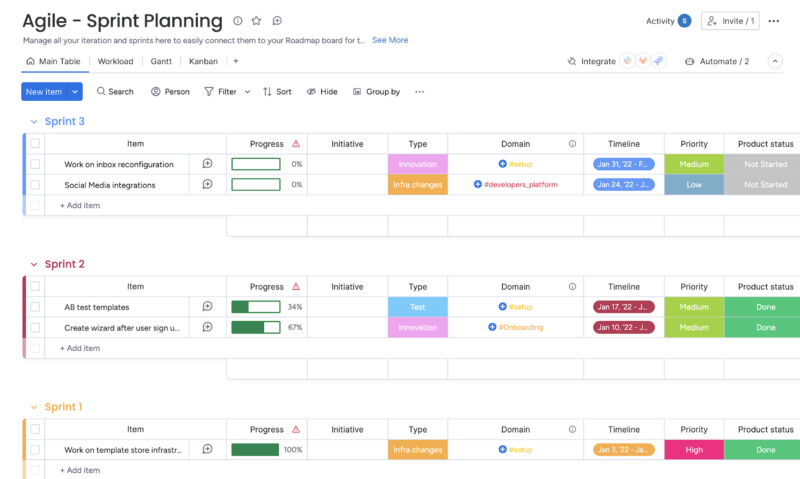
monday.com is a powerful project management software
platform that helps agile teams organize sprints.
Sprint Planning: Who Decides the Duration of a Sprint?
The scrum team, product owner and scrum master collaborate to plan the duration of a sprint, set the sprint goal and scope, review the product backlog, select items and define tasks to accomplish within the next sprint time frame. For a one-month sprint, the maximum sprint planning duration is eight hours.
The sprint duration is also decided during this meeting, along with the definition of done (DoD), which outlines the criteria for considering a task to be complete, and the definition of ready (DoR), which defines when a user story is ready to be taken into a sprint.
What Is a Sprint Review?
A sprint review is an event that occurs at the end of each sprint. Its purpose is to showcase the completed work to stakeholders and gather feedback. This allows stakeholders to provide input and ask questions. The product owners also review the product backlog, and team members evaluate the sprint goal achievement.
What Is Backlog Refinement?
Backlog refinement is an ongoing process where the team collaborates to review, prioritize and prepare backlog items for upcoming sprints. The product owner typically leads the backlog refinement meetings, working closely with the development team to ensure that the product backlog is well-defined and aligned with project goals.
What Is a Sprint Retrospective Meeting?
A sprint retrospective is a meeting held at the end of a sprint that focuses on the team’s internal reflection and improvement. The scrum master (or agile coach) and the team members discuss what went well and what could be improved. They also identify action items using the best agile tools to improve their processes for future sprints.
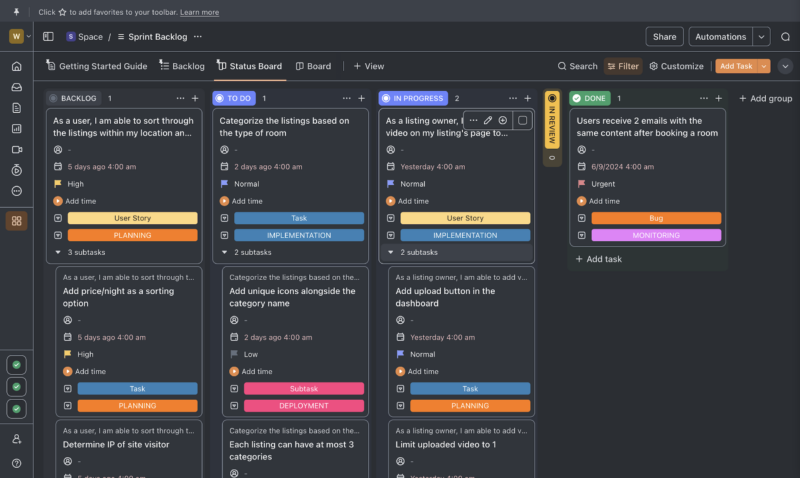
Teams can use ClickUp to effectively manage their sprint backlog
and track progress during sprint reviews.
The Impact of Sprint Length in Agile Projects
Sprint length can have a significant impact on the operations and outcomes of your agile project. Below is a comparison table that highlights the key differences between the impacts of long and short sprints.
| Shorter Sprint Length (1-2 weeks) | Longer Sprint Length (3-4 weeks) |
|---|---|
| Faster delivery of increments | Slower delivery due to longer cycles |
| More frequent opportunities for feedback and course correction | Less frequent feedback from stakeholders |
| More flexibility to adapt to changes | More time for complex tasks and quality assurance |
| Lower risk as issues surface early | Higher risk due to longer decision cycles |
| Help maintain team focus and motivation | Allow for more substantial product increments |
Minimum Sprint Duration: Signs Your Sprints Are Too Short
Short sprints, like a one-week sprint, are suitable for teams that work on small tasks and need immediate feedback. However, a shorter sprint length can lead to inefficiency. Here are five signs that your sprints may be too short.
- Incomplete user stories: With limited time, the team may struggle to complete user stories within a single sprint. This can lead to a backlog of unfinished work.
- Constant context switching: Sprints that are too short force teams to constantly switch between tasks and priorities. This reduces their concentration and slows the project’s progress.
- Burnout and high stress: Short sprints may cause team members to experience burnout or high stress, which can lead to scrum anti-patterns.
- Lack of meaningful testing: Rushed sprints often leave little time for thorough testing and quality assurance, increasing technical debt, risks and issues.
- Increased overhead: Shorter sprints require more frequent sprint planning, retrospectives and other ceremonies, adding more workload to the team.
Strategies for Short Sprint Lengths
Let’s dive into the sprint duration best practices that should be implemented when working with short sprint cycles.
- Set realistic goals: Establish achievable and measurable goals for each sprint. The product owner and scrum master should consider team capacity and resources to avoid overloading teams and ensure task completion within the sprint time frame.
- Prioritize tasks effectively: Regularly review and prioritize your backlog to make sure the team is working on the highest-value items.
- Flexibly adjust sprint durations: To find the optimal duration, teams should experiment with different sprint lengths and adjust them based on feedback and performance data.
- Highlight sustainability: Maintain a sustainable pace for the team by avoiding overcommitment and burnout, prioritizing work-life balance and fostering a supportive environment.
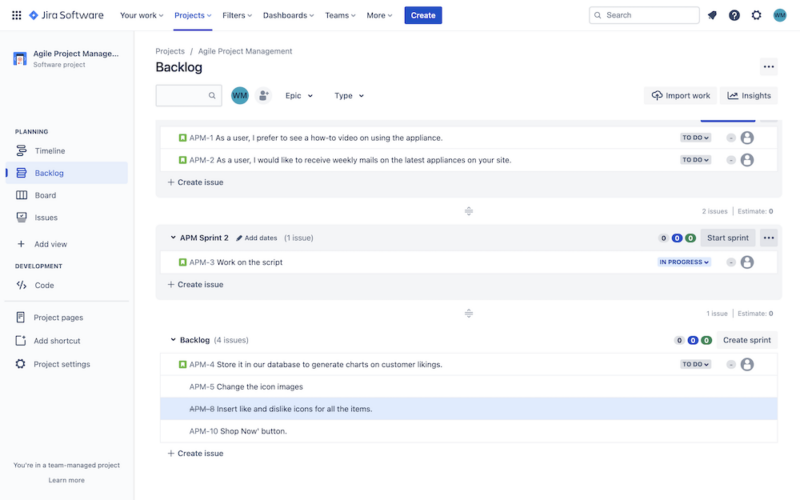
Use project management tools like Jira to track progress,
prioritize tasks and collaborate.
Are Short Sprints Better?
Although both short and long sprints have their own set of advantages and disadvantages, many project management professionals agree that shorter sprints are generally more effective. Here’s a closer look at why.
- Faster feedback loops: Short sprints enable teams to receive feedback, course-correct and make quicker adjustments.
- Improved focus: Shorter time frames can help teams stay focused and motivated, reducing the risk of scope creep.
- Quicker delivery: The team can deliver value to customers or stakeholders more frequently, making it easier to respond to changing market conditions or customer needs.
Can Sprint Duration Be Increased?
In Agile best practices, maintaining consistent sprint durations is recommended to improve predictability and promote a steady workflow. That said, increasing sprint duration can be justified with careful consideration. For example, if a project needs more in-depth research and analysis, or if external factors cause interruptions, a longer sprint duration may be required.
Maximum Sprint Duration: Signs Your Sprints Are Too Long
Although longer sprints — which typically last three to four weeks — allow for more in-depth work, they can lead to more risks and decreased productivity. Here are five signs that your sprints may be too long.
- Decreased team motivation: Extended sprints can drain team energy and enthusiasm, resulting in decreased motivation and engagement.
- Increased scope creep: When the scope of the work keeps expanding or changing within a single sprint, it indicates that the sprint duration may be too long. This can cause confusion, inefficiency and potential delays.
- Delayed feedback: Prolonged feedback loops make it difficult for stakeholders to provide timely feedback, leading to potential misunderstandings and rework.
- Lack of adaptability: Teams may struggle to adapt to changing priorities or unexpected obstacles if the sprint duration is too long.
Strategies for Long Sprint Lengths
When working on projects with long sprint cycles, consider the following strategies to maintain productivity, motivation and adaptability.
- Break down features into smaller user stories: Decompose large features into manageable user stories with clear criteria to stop overwhelming your team, improve focus and track progress more effectively.
- Gradually reduce the sprint duration: Consider gradually decreasing the sprint duration over time — such as from four weeks to three weeks — to find the best length that balances productivity, efficiency and adaptability for your team.
- Conduct regular check-ins and gain feedback: Schedule regular check-in meetings to assess progress, gather feedback and address challenges to keep the sprint on track and support your team.
Are Long Sprints Better?
Certain projects can benefit more from longer sprint durations. Let’s take a look.
- Complex projects: Longer sprints allow the team to work on larger, more comprehensive tasks without constantly switching contexts.
- Research-intensive projects: Projects that involve significant research, data analysis or experimentation can benefit from long sprints, enabling teams to delve deeply into the subject matter, gather insights and iterate on findings.
- Innovation and prototyping: Long sprints can be used in prototyping or projects with cutting-edge technologies to facilitate experimentation and creativity before finalizing a concept or design.
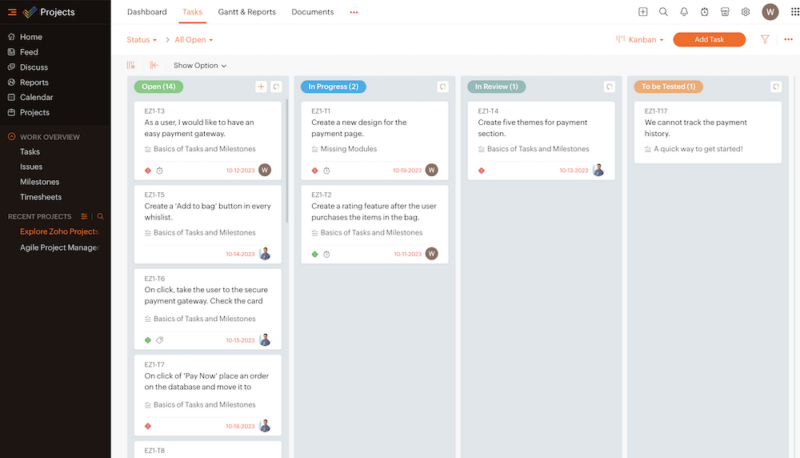
Zoho Projects is a great tool to help teams manage their projects and sprints.
Final Thoughts
In the Agile world, sprint duration is a key component in shaping team dynamics, productivity and project success. Two-week sprints are the most common option for balancing speed and flexibility. Short sprints are ideal for quick feedback, adaptability and concentration, while longer sprints are better suited for larger projects with complex tasks.
Remember, there’s no one-size-fits-all rule for determining the ideal sprint length. You and your team should experiment with different durations while considering factors like team size, project complexity and sprint goals. The right sprint length will allow the team to optimize performance, maintain a sustainable pace, and ultimately, deliver high-quality products.
We’d love to hear your thoughts and experiences. How long do you typically set your sprints for? Have you found that longer or shorter sprints work better for your team? What strategies have you used to determine the optimal sprint length for your projects? Share your insights in the comments below. Thank you for reading.
FAQ: How Long Is a Sprint?
-
A sprint is a fixed time period where a scrum team works to complete a set of defined tasks. Sprint length typically ranges from one to four weeks, but it can vary depending on factors such as team size, project complexity and organizational culture.
-
No, a sprint isn’t always two weeks. The most common length of a sprint is two weeks. However, some teams may find that longer or shorter sprints work better for their project goals and the team’s preferences. Teams should experiment and find the sprint length that works best for them.
-
There is no universal rule for sprint duration. The Scrum Guide, which outlines the Scrum framework, recommends that the maximum sprint length be one month or less. Ultimately, the decision on sprint duration should be based on your team’s needs and goals.
-
Yes, three-week sprints can be suitable for teams working on more complex projects or those with larger team sizes, providing a good balance between continuous delivery and agility.
A sprint is a fixed time period where a scrum team works to complete a set of defined tasks. Sprint length typically ranges from one to four weeks, but it can vary depending on factors such as team size, project complexity and organizational culture.n”}},{“@type”:”Question”,”name”:”Is a Sprint Always 2 Weeks?”,”acceptedAnswer”:{“@type”:”Answer”,”text”:”
No, a sprint isnu2019t always two weeks. The most common length of a sprint is two weeks. However, some teams may find that longer or shorter sprints work better for their project goals and the teamu2019s preferences. Teams should experiment and find the sprint length that works best for them.n”}},{“@type”:”Question”,”name”:”Is There a Rule on Sprint Duration?”,”acceptedAnswer”:{“@type”:”Answer”,”text”:”
There is no universal rule for sprint duration. The Scrum Guide, which outlines the Scrum framework, recommends that the maximum sprint length be one month or less. Ultimately, the decision on sprint duration should be based on your teamu2019s needs and goals.n”}},{“@type”:”Question”,”name”:”Can a Sprint Be 3 Weeks Long?”,”acceptedAnswer”:{“@type”:”Answer”,”text”:”
Yes, three-week sprints can be suitable for teams working on more complex projects or those with larger team sizes, providing a good balance between continuous delivery and agility.n”}}]}]]>
Let us know if you liked the post. That’s the only way we can improve.

